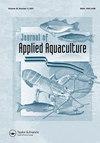Energetic metabolism of Piaractus mesopotamicus fed with starch sources in the diet
IF 0.8
Q3 FISHERIES
引用次数: 0
Abstract
ABSTRACT This work was to evaluate the effect of different starch sources on the performance and metabolism of Piaractus mesopotamicus. Three isonitrogenous (300 g kg−1 crude protein) and isolipidic (55 g kg−1 crude lipid) diets containing carbohydrate sources (corn, broken rice or sorghum) were formulated. Each experimental diet was fed to five groups (25 fish, 12.13 ± 0.09 g, per tank), three times a day during a period of 60 days. Cholesterol was lower in sorghum, and high density lipoproteins and hepatic glycogen were higher with the use of sorghum (P < .05). Low density lipoprotein was higher when feeding with corn. Plasma glucose was higher in treatments with broken rice and corn. Sorghum led to lower values of hepatosomatic, visceral and digestive somatic indexes. Enzymes activities (amylase, lipase, maltase) reduced their activities in fish fed with sorghum. Broken rice resulted in higher lipid content and lipid retention coefficient in whole fish. The data suggest that the growth of Piaractus mesopotamicus and digestibility are not affected by the chemical composition of starch from the carbohydrate sources tested, however, different metabolic behaviors occurred, either from the starch content in diet, the starch composition of each ingredient, or the pro-nutritional effect of sorghum.日粮中添加淀粉源对美索不达米亚伯爵的能量代谢
本文章由计算机程序翻译,如有差异,请以英文原文为准。
求助全文
约1分钟内获得全文
求助全文
来源期刊

Journal of Applied Aquaculture
Environmental Science-Ecology
CiteScore
3.20
自引率
0.00%
发文量
38
期刊介绍:
The Journal of Applied Aquaculture is a platform for the sharing of practical information needed by researchers to meet the needs of investors, farm managers, extension agents and policy makers working to adapt aquaculture theory to achieve economic and food security objectives in the real world. The journal emphasizes multi-disciplinary research and case studies that propose financially and logistically viable solutions to observable problems.
 求助内容:
求助内容: 应助结果提醒方式:
应助结果提醒方式:


